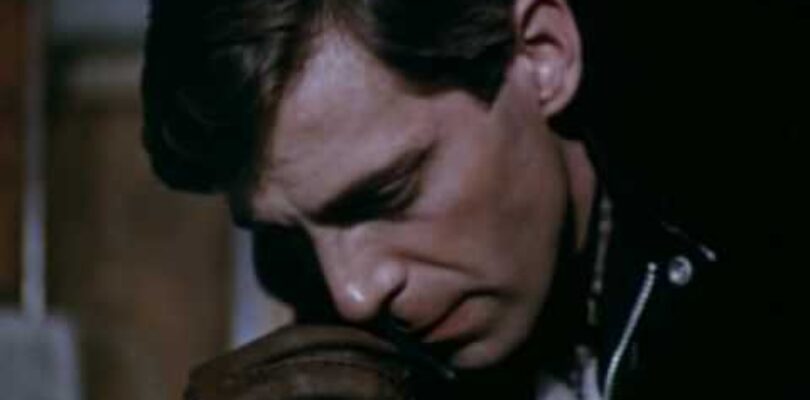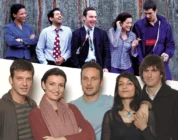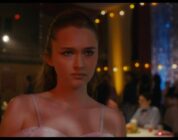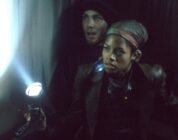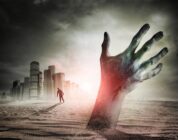BRAAAINS! It’s what zombies want, and what their films already have. It’s ironic really that horror movies about the mindless undead actually have the most on their mind. We have writer-director George A. Romero to thank for that. He pioneered the modern zombie film with 1968’s Night of the Living Dead, a not-so-thinly veiled attack on American bigotry. A decade later, he returned with Dawn of the Dead, more expansive in setting, budget, and run time, a magnum opus whose biting critique of humanity cuts even deeper.
The ’78 sequel opens with a scene at a local news station. As an expert tries desperately to warn viewers of the dangers of the zombie epidemic, skeptical producers and PAs roll their eyes, while Francine (Gaylen Ross) pleads with her boss not to spread disinformation that could wrongly embolden citizens to leave the safety of their homes. The critique of the news media would pair well with Network, which premiered just two years earlier, or 2021’s Don’t Look Up, about the failure of the media to warn viewers of an asteroid that will hit earth. In Dawn of the Dead, we don’t stay in the news station long, but it sets the stage of an incisive critique—not just of the media but of all humankind. These humans are both mindless and dangerous.
Eventually, Francine and her traffic reporter boyfriend, Stephen (David Emge), combine forces with two SWAT team officers, Peter (Ken Foree) and Roger (Scott H. Reiniger), and find solace from the mayhem in a shopping mall, which has its share of undead but offers safety from the outside world and plenty of nooks and crannies where our heroes can hide. The humans block off the entrances giving them a controlled environment to navigate around the slow-moving monsters (nothing like the early aughts versions with their preternatural speed), allowing the quartet to exist comfortably. At 139 minutes, Dawn of the Dead gives them so much time in the mall, you get the sense of a life lived amid the shops, water fountains, and food courts.
Romero reportedly conjured the whole idea of the film while at a mall, and it’s easy to imagine what sparked his interest. He must have simply looked at the throngs of people moving from shop to shop, spending their hard-earned money to perpetuate the very systems that oppress them, and thought: zombies.
“Why are they here?” asks Francine about the hordes of undead trying to make their way into the mall.
“Some kind of instinct or memory,” responds Stephen. “This was an important place in their lives.”
We see this importance not just in the zombies but in the living. It’s there in the giddy thrill Peter and Roger get from raiding the department stores for clothing and the sporting goods store for guns and ammunition. A mall filled with life-threatening monsters is just an opportunity for the ultimate shopping spree.
The delightful twist in Dawn—one that has become the seminal plot for many future zombie stories—is that the living pose a greater threat than the undead. In the film’s final third, a gang of nomadic bikers spot our heroes on the mall roof and decide to break in, where they giddily torture the zombies and wage war with the humans. It’s a literalization of Dawn’s critique of humanity, where the relatively mild flaws of our heroes are magnified in the behavior of the antagonists. In these scenes, you might actually find yourself feeling bad for the zombies, who are helpless against the thugs’ sadistic games. Dawn of the Dead is the rare horror film to make you side with the monsters by making the humans even more evil.
Beyond its thought-provoking narrative, Dawn of the Dead remains a visceral treat for fans of lo-fi horror. The black-and-white aesthetic of Night of the Living Dead beautifully masked its low-budget special effects, but Dawn takes place mostly in daytime and under the mall’s fluorescent lights, rendering some of the effects goofy by today’s standards: The actors playing zombies smeared in silly blue makeup to conjure a deathly pall; their blood is cartoonishly red, the favored aesthetic of Giallo master Dario Argento, who co-produced the film. The human flesh, when bitten, looks more like a plant-based chicken product, rubbery but admittedly succulent. Ignorant viewers, or fans who (incorrectly) prefer the film’s slicker 2004 remake, will see these as flaws, but there’s an instinctive thrill in this low-budget production. Whether it’s impossible poultry or Dawn of the Dead’s deeply resonant themes, you can feel teeth biting into something, and that’s more than you can say about most horror blockbusters today.
As spotlighted in our Spring Arts Guide, Dawn of the Dead’s 45th anniversary will be celebrated with screenings at 7:10 and 9:45 p.m. on April 12 at AFI Silver. Tom Fallows, author of George A. Romero’s Independent Cinema: Horror, Industry, Economics, will introduce the film.
Additional showtimes start at 9:25 p.m. on April 13; 9:30 p.m. on April 14, and 9 p.m. on April 18. silver.afi.com.

